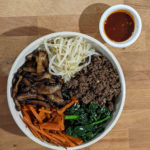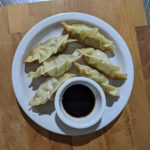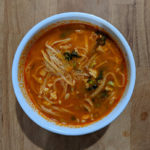Jinyoo Hong and Eunsun Ha:
2020 grads and aspiring restaurateurs
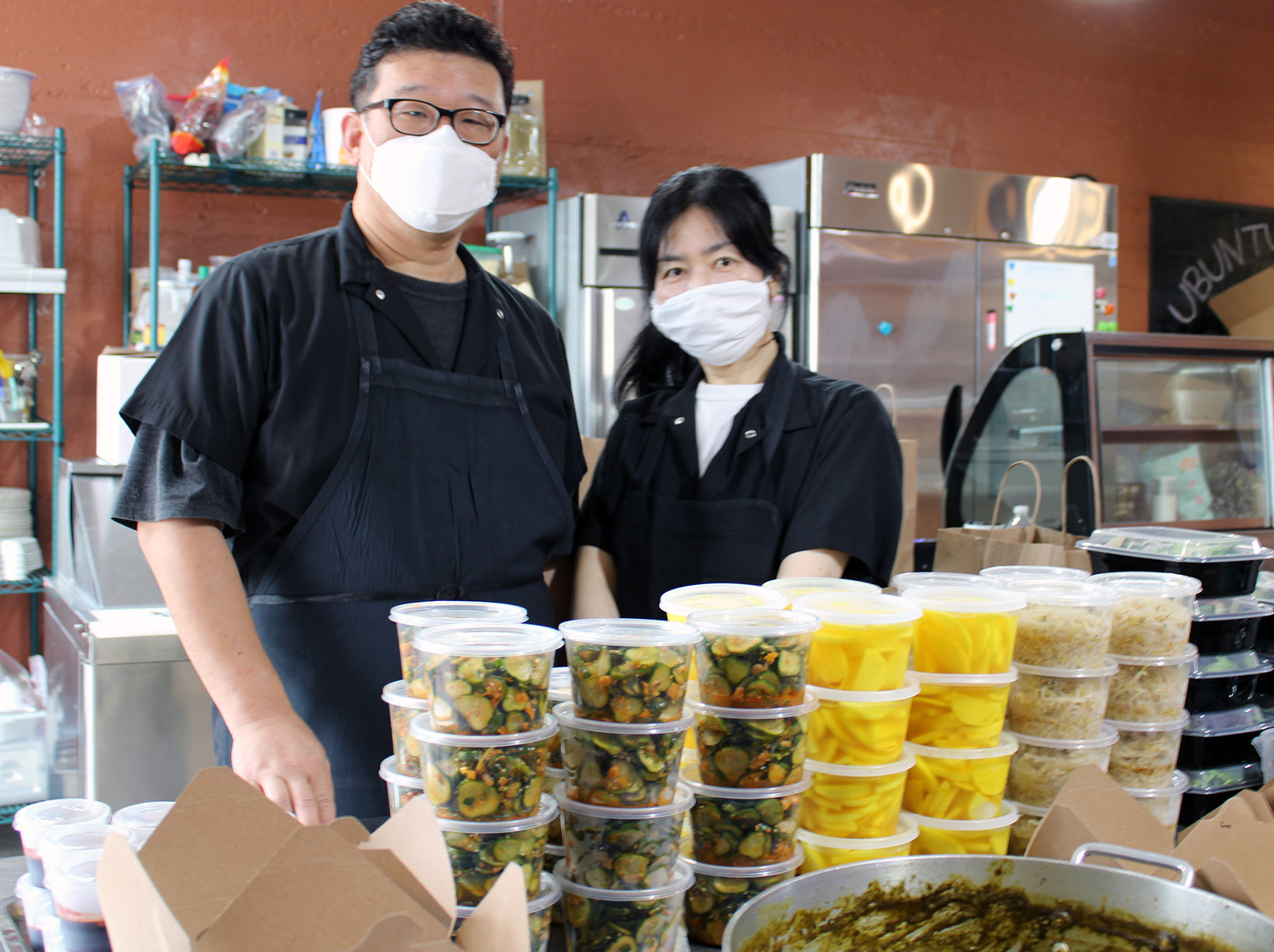
“If you understand food in the context of culture, you will enjoy it more.”
Jinyoo Hong and Eunsun Ha see their Project Feast apprenticeship as a step toward opening their own restaurant.

Jinyoo Hong at his Auburn home with one of the couple’s five dogs.
Jinyoo Hong is a woodworking artist, a career veteran of global financial-services giant ING, and until last year, the owner of the popular Monster Boxing Club in Changwon, South Korea.
Now, in his adopted home of Seattle, Jinyoo is pursuing a new dream: He wants to open a restaurant that brings together his passions for Korean art and food. “Food is a big part of a nation’s culture, so if you understand food in the context of culture, you will enjoy it more,” he says.
Jinyoo envisions serving authentic Korean cuisine in a location that celebrates Korean visual art, along with K-pop music and K-drama television. His restaurant’s working name is Bapsang, which means “table.” “It would be a cultural space where art and food coexist,” he says. “That’s my restaurant concept of the future that I dream of.”
This year, Jinyoo started the journey to bring Bapsang to life – and Project Feast was his first step.
Jinyoo discovered the Project Feast apprenticeship soon after he and his wife, Eunsun Ha, arrived in the Seattle area in late 2019 to be close to their son, who is studying at the University of Washington. Jinyoo saw the program offered an introduction to the food industry, and he urged his wife to enroll with him.
“At first, I thought it was a class for learning English,” Eunsun says with a chuckle. “It was kind of a surprise. This is more cooking than speaking English.”
JINYOO AND EUNSUN HAVE BEEN TOGETHER since their undergraduate days in Changwon, South Korea’s ninth-largest city. He was studying Eastern philosophy, and she was studying to be a history teacher. Back then, neither had much experience cooking, although Jinyoo had experimented a little in the kitchen as a child. “I used to cook because my mother was always working at school,” he remembers. “I would cook something like instant ramen. It’s quite popular. It’s easy to cook. It was my first start.”
“I didn’t really cook that much before marriage,” Eunsun says. “When I was young, I would make a fried egg with soy sauce and sesame oil and sesame seeds and rice. It was like an egg rice with soy sauce. I still make it for my son. It’s my best one.”

Jinyoo Hong and Eunsun Ha at the Ubuntu Street Cafe in Kent.
After they were married, the couple lived in the U.S. for a short time in the late 1990s while Jinyoo studied communications at the University of Tennessee. The Korean economic crisis of 1998 forced them to return home earlier than planned, and over the years they looked for an opportunity to come back to America. Five years ago, they started the process to return as permanent residents while their son was in college.
“Living in Korea, where natural resources are scarce and the domestic market can only flourish due to exports, the situation creates excessive stress amid fierce competition every day,” Jinyoo says. “If Korea is a light and excellent yacht-like country, the United States is the world’s strongest country that provides stability like an aircraft carrier.”
LAST FALL, JINYOO AND EUN JOINED THEIR SON in the Seattle area with their five beloved dogs – three of them pure Jindo, a traditional Korean hunting breed – and Jinyoo began exploring how to build a business that would incorporate his love for Korean arts. He has a master’s degree in fine arts and exhibited his own woodworking art extensively in South Korea. “Because of this, I have friendships with many Korean artists,” he says. He came up with Bapsang as a way to make Korean art accessible to a wider audience. “I would like to introduce the works of Korean art and craft artists to help Americans understand and enjoy not only Korean food, but also culture.”
Project Feast provided the foundation to start planning the restaurant. He and Eunsun learned American measuring systems along with kitchen skills – like using a mandolin to make quick work of transforming a small mountain of cucumbers into slices perfect for pickling. And they studied how American menus are structured. “We eat with a main dish and rice and banchan [side dishes],” he says. “We don’t have an appetizer, main dish and dessert.”
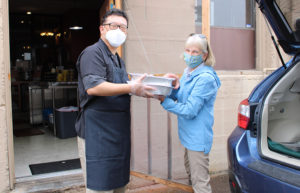
Jinyoo carries packaged family meals to a customer’s car.
They used the apprenticeship to work through versions of dishes that could make their way onto a future Bapsang menu. For their Project Feast graduation meal, they made oven-roasted chicken in Korean barbeque sauce, with a vegetarian option of tofu, served over white rice. Their banchan included danmuji (daikon pickled with turmeric in a vibrant yellow), oi kimchi (cucumber kimchi) and kongnamul muchim (bean sprouts lightly seasoned with garlic and sesame oil).
They tested at least five versions of their graduation dishes, playing with the recipes to make them more appealing to American diners. “Korean food is a bit of a strong flavor. Sometimes it’s very hot-spicy,” Jinyoo says. “Some people like it, but most people are a little bit afraid of it.”
In the end, they settled on a sweeter and less spicy version of the meal than they would typically make. “We were thinking that it’s not just for Koreans,” he says. “We want it to be enjoyable for Americans.”
Project Feast also gave Jinyoo and Eun the opportunity to try new cuisines, like the Kenyan rice dishes made by a classmate, and the program helped them meet people in their new community while learning how to run a food business. “I don’t have any friends here, but whenever I come to the [program’s] cafe, I feel like I have a friend or family,” Eunsun says. “I feel a coziness. I enjoy all of the people here.”
The couple is still working together part-time in the Project Feast kitchen this fall – but at home, they don’t cook together much. “She doesn’t like me cooking at home because while I’m cooking, I make such a mess,” he says. “She is kind of a perfectionist.”
Jinyoo plans to continue working on the Bapsang restaurant concept while attending a two-year culinary program at nearby Renton Technical College when the coronavirus threat eases and classes are allowed to resume. “We believe that the greatest strength of American society is its capacity for diversity, which will make the United States increasingly great,” Jinyoo says. “Through [Bapsang], I want to contribute a little to the American society as a new immigrant. I would like to contribute a little to making this society richer.”
– Interview and writing by Denise Clifton, Tandemvines Media

Jinyoo and Eunsun at home.
Bibimbap
1 hour 10 minutesIngredients
Ground Beef Marinade:
- 8 oz ground beef
- 3 garlic cloves, minced
- 1 tbsp soy sauce
- 1 tbsp sesame oil
- 1 tbsp sugar
Vegetables:
- 2 carrots, large, cut into 2 1/2-inch batons
- 1 bunch of spinach, cut into 2-inch lengths
- 8 shiitake mushrooms, sliced
- 4 cups bean sprouts
- 2 tsp garlic, minced
- 1/2 tsp salt
- 1 1/2 tsp soy sauce
- 1/4 tsp sugar
- sesame oil to taste
- 8 tsp vegetable oil
Bibimbap Sauce:
- 4 tbsp gochujang paste
- 2 tbsp sesame oil
- 2 tbsp sugar
- 2 tbsp rice vinegar
- 1 tbsp garlic, minced
- 1 tbsp soy sauce
- 1 tbsp sesame seeds
For Serving:
- 4 cups cooked white rice (short grain)
- 2 tsp sesame seeds
- fried eggs (optional)
Instructions
Marinated Beef:
- 1. Mix the marinade in a bowl, then add beef.
- 2. Marinate for 30 minutes.
- 3. Heat 2 tsp oil in a pan over high heat and add marinated beef. Cook for 3 to 4 minutes until cooked.
Vegetables:
- Shiitake: Heat 2 tsp oil in a pan over medium-high heat. Cook mushrooms for 2 minutes. Add 1 1/2 tsp soy, 1/4 tsp sugar, 1/2 tsp of garlic. Stir for 1 minutes, then remove.
- Carrots: Add 2 tsp oil into the pan. Cook carrots until just tender and sprinkle with 1/4 tsp salt.
- Spinach: Heat 2 tsp oil in the pan and add spinach. Saute until starting to wilt. Add 1/2 tsp garlic, 1 tsp sesame oil and salt to taste. When cool, squeeze to drain out excess liquid.
- Bean sprouts: Simmer in water for 5 min until floppy. Drain under cold water, then cool. Squeeze out excess liquid with hands, place in bowl. Mix with 1 tbsp sesame oil, 1 tsp garlic and salt to taste.
- Note: Vegetables can cool, they are meant to be at room temp.
Sauce:
- 1. Combine all ingredients for sauce
- 2. Mix until sugar is dissolved.
Assemble:
- Place warm cooked rice in a bowl.
- Top with vegetables and beef. If you have eggs around, fry one up and place on top.
- Sprinkle with sesame seeds, drizzled with sesame oil. Serve with Bibimbap Sauce.
Danmuji (Korean Yellow Pickled Radish)
Ingredients
- 1 1/2 cups water
- 1 1/2 cups rice vinegar
- 1/2 cup sugar
- 1 tbs kosher salt
- 1 medium clove garlic, crushed
- 1 tsp turmeric powder
- 15 whole black peppercorns
- 2 bay leaves
- 1 lb daikon radish, peeled and sliced into rounds 1/8” thick
Instructions
- 1. In a medium saucepan, stir together water, vinegar, sugar, salt, garlic, turmeric, peppercorns and bay leaves. Bring to a boil over medium-high heat, stirring to ensure that sugar fully dissolves.
- 2. Remove from heat and add daikon. Press a paper towel directly against the surface of the brine and let cool to room temperature, 1 to 2 hours.
- 3. Transfer pickles and brine to an airtight glass container and store in the refrigerator. (Note: The turmeric will stain a plastic container yellow).
- Pickles are ready to eat the next day and will last up to 1 month.
- Makes 1 large jar
Korean Dumplings (Mandu)
1 hourIngredients
Dumplings:
- 1 1/2 lbs ground pork
- 1 1/2 cups napa cabbage, finely chopped
- 1/2 cup green onion, finely chopped
- 1 cup chives, finely chopped
- 3 cloves garlic, finely chopped
- 1 tsp ginger, minced
- 1 tbsp sesame oil
- 2 tbsp soy sauce
- 1 tsp salt
- 1 tsp sugar
- 1 tsp pepper
- Vegetable oil
- 1 package circular mandu wrappers (or Japanese gyoza or Chinese wonton wrappers)
Dipping sauce:
- 1 tbsp soy sauce
- 1 tbsp vinegar
- 1 tbsp water
- 1/2 tbsp sugar
- 1 tsp gochugaru (Korean red pepper flakes)
Instructions
- 1. Gather the ingredients
- 2. In a large mixing bowl, gently combine ground pork, napa cabbage, green onions and chives.
- 3. In a separate small bowl, combine garlic, ginger, sesame oil, soy sauce, sugar, salt and pepper.
- 4. Pour seasoning mixture over meat and vegetables and mix with hands to combine.
- 5. Place about 1 tbsp of filling in the center of dumpling wrapper.
- 6. Dip your finger in water and wet the perimeter of half of the wrapper.
- 7. Fold the wrapper in half, pressing to seal and then crimp the edges.
- 8. Heat a medium skillet over medium-high heat. Pour in enough oil to coat the bottom of the pan. Add the mandu so that they all sit flat in one layer. Cook for 1 minute (or until bottom is slightly brown). Add 4 tbs water. Cover the pan and let steam for 5 to 6 minutes.
- 9. Turn off heat and let the pan sit, covered, for another 1 to 2 minutes.
- 10. Transfer mandu to a plate and serve with basic dipping sauce and a side of danmuji (pickled daikon)
- Makes about 60 dumplings.
Soon Tofu Jjigae (Korean Silken Tofu Stew)
50 minutesIngredients
- 2 tbsp cooking oil
- 2 tbsp gochugaru (Korean hot pepper flakes)
- 1/2 cup napa kimchi, chopped
- 8 cloves garlic, minced
- 4 cups vegetable stock
- 1 tbsp gochujang (Korean hot pepper paste)
- 1 tbsp dwenjang (Korean bean paste)
- 16 oz silken tofu or soft tofu
- 8 oz enoki mushrooms
- 4 green onions, chopped
- 2 eggs, beaten lightly
Instructions
- 1. Heat the oil in a medium pot over medium-high heat. Add gochugaru, stirring until oil turns red.
- 2. Add kimchi and garlic. Stir to coat in oil and let cook for 1 minute.
- 3. Add in stock. Stir in hot pepper paste and bean paste. Bring to boil.
- 4. Once the kimchi is tender, add in the tofu. Break up larger chunks gently with a spoon.
- 5. Let the stew boil for 10 to 15 minutes to allow flavors to develop and add eggs slowly, mixing as you pour them in.
- 6. Just before serving, mix in the enoki mushrooms and top with green onions.
- Serve it with rice and other Korean side dishes (banchan).
Vegan Kimchi
Ingredients
- 3 large heads of napa cabbage, chopped into 2-inch pieces
- 1 cup kosher salt
- 10 cloves garlic, sliced
- 1 2-inch piece of ginger, peeled and minced
- 1 cup gochugaru (Korean chili flakes)
- 1 bunch of green onions, sliced
Instructions
- 1. Put the cabbage in a large colander set over a bowl or in the sink. Toss the cabbage with the salt. (Using your hands is the best method for this.) Let sit for about 40 minutes to express some of the excess moisture.
- 2. After 40 minutes, dump any liquid, rinse off the excess salt, and pat the cabbage dry with a clean kitchen towel.
- 3. Pour the cabbage into a clean bowl and add the garlic, ginger, gochugaru and green onions. Toss well. Loosely cover, and let sit overnight or longer (up to 3 days). Stir and taste every 12 hours or so, and move on to the next step when the flavor is to your liking.
- 4. Pack the kimchi tightly into clean containers large enough to include enough liquid to cover all the solids. If needed, add a small amount of cold water to top off the jars.
- 5. Refrigerate, covered, immersed in the brine, for up to 2 months.
- Makes 5 pints

